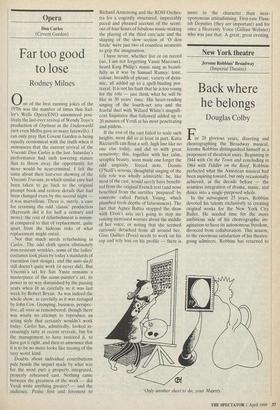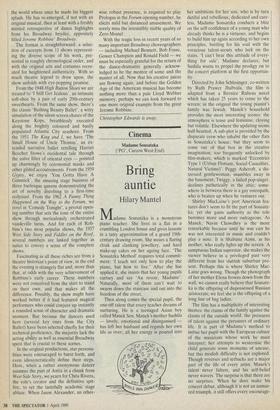New York theatre
Jerome Robbins' Broadway (Imperial Theatre)
Back where he belongs
Douglas Colby
For 20 glorious years, directing and choreographing the Broadway musical, Jerome Robbins distinguished himself as a proponent of theatrical unity. Beginning in 1944 with On the Town and concluding in 1964 with Fiddler on the Roof, Robbins perfected what the American musical had been aspiring toward, but only occasionally achieved, in the decade before — the seamless integration of drama, music, and dance into a single-purposed whole.
In the subsequent 25 years, Robbins devoted his talents exclusively to creating Original' works for the New York City Ballet. He needed time for the more ambitious side of his choreographic im- agination to have its autonomous freedom, divorced from collaboration. This season, to the enormous satisfaction of his theatre- going admirers, Robbins has returned to 'Only another sheet to do, your Majesty.' the world where once he made his biggest splash. He has re-emerged, if not with an original musical, then at least with a freshly minted retrospective of dance highlights from his Broadway heyday, appositely titled Jerome Robbins' Broadway.
The format is straightforward: a selec- tion of excerpts from 11 shows represent- ing the diverse scope of his work, pre- sented in roughly chronological order, and with the original sets and costumes recre- ated for heightened authenticity. With so much theatre legend to draw upon, the show unfolds with eye-popping promise.
From the 1948 High Button Shoes we are treated to 'I Still Get Jealous', an intimate
soft-shoe by a pair of early 20th-century sweethearts. From the same show, there's the classic 'Bathing Beauty Ballet', a witty simulation of the silent-screen chases of the Keystone Kops, breathlessly executed along the brightly coloured and busily populated Atlantic City seashore. From
the 1951 The King and I, we have 'The Small House of Uncle Thomas', an ex-
tended narrative ballet retelling Harriet Beecher Stowe's occidental tale through the naive filter of oriental eyes — pointed up charmingly by ceremonial masks and
other gilded accoutrements. From the 1959 Gypsy, we enjoy 'You Gotta Have A
Gimmick', the amusing stage business of three burlesque queens demonstrating the art of novelty disrobing to a first-time
ecdysiast. From the 1962 A Funny Thing Happened on the Way to the Forum, we revel in 'Comedy Tonight', a pivotal open-
ing number that sets the tone of the entire show through meticulously orchestrated vaudeville turns. And for each of Rob-
bins's two most popular shows, the 1957 West Side Story and Fiddler on the Roof, several numbers are linked together as suites to convey a sense of the complete shows.
Fascinating as all these riches are from a theatre historian's point of view, in the end the evening is strangely flat and, more than that, at odds with the very achievement of Robbins's early career. These numbers were not conceived from the start to stand on their own, and that makes all the difference. Possibly, the show might have worked better if it had featured magical performers who could conjure up instantly a rounded sense of character and dramatic moment. But because the dancers used here (several key ones from the City Ballet) have been selected chiefly for their technical proficiency, the majority lack the acting ability as well as essential Broadway spirit that is crucial to these scenes.
In the original productions, star persona- lities were encouraged to burst forth, and even idiosyncratically define their steps.
Here, when a rather anonymous dancer assumes the part of Anita in a chunk from
West Side Story, we yearn for Chita Rivera, the role's creator and the definitive spit- fire, to set the tastefully academic stage ablaze. When Jason Alexander, an other- wise robust presence, is required to play Prologus in the Forum opening number, he elicits mild but distanced amusement. We sorely miss the irresistibly risible quality of Zero Mostel.
With the tragic loss in recent years of so many important Broadway choreographers — including Michael Bennett, Bob Fosse, Gower Champion and Ronald Field — we must be especially grateful for the return of the dance-dramatist generally acknow- ledged to be the mentor of some and the master of all. Now that his creative juices are flowing again, and before the Golden Age of the American musical has become nothing more than a pale Lloyd Webber memory, perhaps we can look forward to one more original example from the great Jerome Robbins.



















































 Previous page
Previous page